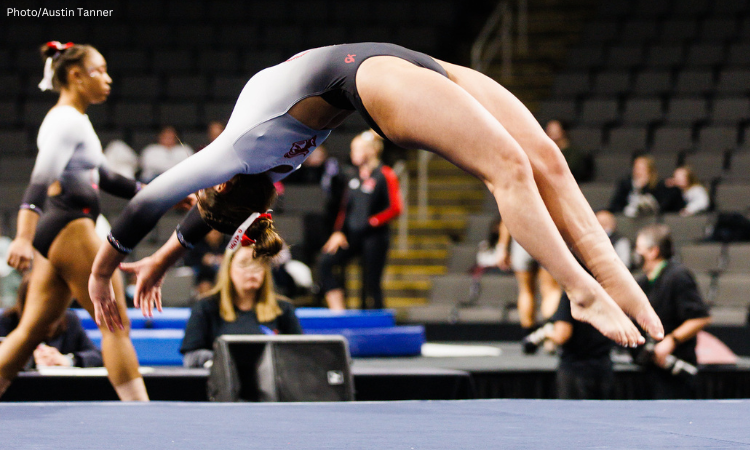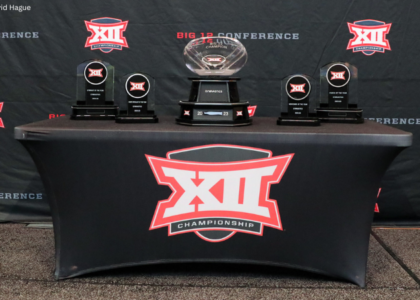These last three seasons of college gymnastics have been unique; the option for athletes to take a fifth year has lent a new level of intrigue to the sport, affecting team rosters and scholarship availability. An equally impactful—though perhaps lesser known—change was the new code that took effect for the 2020 season. For years, the building blocks of a typical college floor routine consisted of three tumbling passes combined with required dance elements. Barring extenuating circumstances like nagging injuries, two-pass routines were few and far between. As a result of the new code, that norm is changing, and two-pass routines are quickly supplanting three-pass sets as the go-to construction for teams in Power Five schools.
Beginning with the 2020 season, the baseline start value for a floor routine decreased from 9.5 to 9.4. To balance out this change, the NCAA added extra opportunities for athletes to earn the six tenths of bonus required for their routine to start from a 10.0. The change most frequently reported on is the one-tenth difficulty bonus for the final tumbling pass being a double salto or an E-valued acro skill (a few examples being twisting double saltos, back triple twists, or front double twists.) The other added bonus opportunity is awarded when an athlete directly connects two C-valued acro skills (examples include back double twists, back one and a half twists, and front layout fulls.)
In a 2020 interview, Utah head coach Tom Farden told the Salt Lake Tribune that the team would be foolish not to use the code of points to its advantage. He added that the reduced pounding on the body was beneficial for the gymnasts, especially those coming back from injury. After all, college gymnasts compete almost every week for three and a half months, so any additional opportunities to get them to the postseason healthy is a welcomed change.
Farden wasn’t the only coach to take that approach. Since 2020, the frequency of two-pass routines has only increased. We analyzed the floor routine composition of each gymnast who competed for a Power Five school (Big Ten, Big 12, Pac-12, SEC) starting in 2019—the year before the impactful code changes—through the 2023 season. While there were a handful of routines that couldn’t be found online, the vast majority of them were available to watch on YouTube or well-documented in one of CGN’s live blogs. (Note that this list included schools whose conference sponsored gymnastics at the time of competition and didn’t take into account future conference changes, such as BYU moving to the Big 12 or the advent of the ACC.)
In 2019, only 13.5% of floor routines that made it to the competition floor were two-pass routines; that amounts to 33 of 244 available routines. Nineteen additional gymnasts competed floor that season, but there was no video or live blog documentation of those routines.
In 2020, the percent of two-pass routines rose to 22.5%, or 55 routines. That’s nine percentage points higher than 2019. While the season was shortened due to the COVID-19 pandemic, the sample size was the same as in 2019. There was a larger amount of routines available online, and we were able to locate 244 of the 254 routines.
2021 saw another increase, with 31.9% of routines, or 81 gymnasts, using just two tumbling passes, another approximately nine percentage point increase. Nearly every gymnast’s routine from that season was documented in some form, with our sample including 254 of 255 gymnasts’ routines.
2022 rose even higher: 42.5% of routines were two-pass routines—that’s 11 percentage points higher than the previous year. That equates to 114 gymnasts out of the 268 who competed; we couldn’t find evidence of eight routines.
This past season, over half of the gymnasts who competed performed two-pass routines, or 59.2%. That’s 104 out of 255 gymnasts who competed; two routines were undocumented.
If this trend is any indication, we’ll be seeing more two-pass routines in the future, not fewer. Minimizing deductions and the prevalence of injury is the name of the game, and, as Farden said, coaches will continue working the code to benefit their athletes and increase their team’s chances of success in the increasingly competitive college gymnastics landscape.
READ THIS NEXT: Data Deep Dive: UCLA in the Big Ten
Article by Tara Graeve with additional assistance from Mariah Dawson
Like what you see? Consider donating to support our efforts throughout the year!





One comment